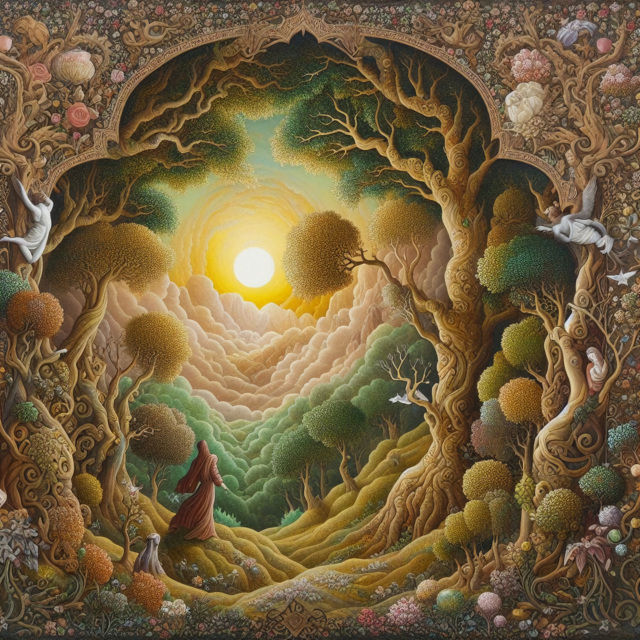Unveiling the Secrets of Saadi Shirazi’s Masterpiece.
In the realm of Persian literature, few works have captured the essence of love, spirituality, and morality quite like Bustan (The Orchard) by Saadi Shirazi. This 13th-century masterpiece has left a lasting impact on Persian poetry, and its themes continue to resonate with readers to this day. As an art historian, I am eager to delve into the intricacies of Bustan and uncover the secrets that make it a timeless work of art.
Background and Context
Saadi Shirazi, also known as Shaikh Saadi, was born in Shiraz, Iran in 1210 CE. He was a prominent poet, literary theorist, and Sufi mystic who lived during the Mongol invasion of Persia. His life was marked by political turmoil, social upheaval, and personal hardships, which deeply influenced his writing. Bustan, considered one of his greatest works, reflects the tumultuous era in which he lived and offers a glimpse into the human experience during that time.
Structure and Themes
Bustan completed in 1257, is composed of ten chapters, each addressing a different aspect of human life. The poem explores themes such as love, wisdom, morality, and spiritual growth through allegories, fables, and anecdotes. The narrative structure is interspersed with lyrical poems, which add depth and emotion to the text.
One of the most striking features of Bustan is its use of symbolism. Saadi employs the metaphor of the orchard to represent the garden of life, where trees symbolize individuals and their various states of being. The cypress tree, for instance, represents the spiritually advanced person, while the willow tree signifies humility and flexibility. Throughout the poem, Saadi weaves together elements of nature, moral teachings, and spiritual insights to create a rich tapestry of meaning.
Love and Spirituality
Love is a central theme in Bustan, particularly the concept of divine love. Saadi sees love as a transformative force that can elevate the soul towards union with God. In Chapter Three, he writes, “Love is the foundation of faith; / Whosoever hath loved, hath known the Lord.” Love is not limited to romantic or earthly love but encompasses all forms of affection, including love for family, friends, and community.
Spirituality is another dominant motif in Bustan. Saadi believes that true happiness and fulfilment come from attaining inner peace and proximity to God. He emphasizes the importance of self-reflection, purification of the heart, and adherence to ethical principles. In Chapter Seven, he advises, “Behold! The world is a mansion of sorrow; / Make thy heart pure, that thou mayst find felicity.”
Morality and Ethics
Bustan offers valuable insights into the ethical and moral values of Persian society during the 13th century. Saadi stresses the significance of justice, compassion, generosity, and humility. He criticizes those who prioritize material wealth over spiritual growth and condemns oppression, hypocrisy, and other vices. In Chapter Five, he laments, “Alas! That man doth seek after wealth and glory; / But, O my friend! Seek knowledge and wisdom.”
Saadi’s message transcends religious boundaries, promoting universal values that are relevant even today. His emphasis on leading a virtuous life, treating others with kindness, and cultivating inner beauty remains inspiring and pertinent.
Literary Significance and Impact
Bustan has had a profound influence on Persian literature and culture. It is considered one of the greatest works of Persian poetry, and its themes have been echoed in subsequent works by other authors. The poem’s use of symbolism, imagery, and allegory has inspired countless writers and poets, shaping the course of Persian literature.
Beyond Persia, Bustan has reached distant lands and cultures. Its translation into Turkish, Arabic, and European languages has made it accessible to a broader audience, contributing to its enduring legacy. The poem’s universality lies in its ability to speak to people across cultures and centuries, offering insights into the human condition that are just as relevant today as they were when the poem was first written.
One of the keyways in which Bustan achieves this universality is through its use of symbolism. Saadi uses the image of the orchard to represent the garden of life, where trees symbolize individuals and their various states of being. The cypress tree, for example, represents the spiritually advanced person, while the willow tree signifies humility and flexibility. By using these symbols, Saadi creates a rich tapestry of meaning that can be applied to people’s lives regardless of their cultural background or historical context.
Another way in which Bustan transcends time and place is through its focus on the emotional and psychological aspects of human experience. The poem explores themes such as love, longing, and spiritual yearning in a way that resonates deeply with readers. For example, in Chapter Three, Saadi writes, “My heart is filled with grief and pain, / Like a river that flows with tears in vain.” These lines capture the universal human experience of suffering and loss, and remind us that we are all connected through our shared emotions and experiences.
Furthermore, Bustan’s emphasis on the importance of ethical conduct and moral character is another aspect of its universality. Saadi stresses the need for individuals to lead a virtuous life, treat others with kindness, and cultivate inner beauty. These values are timeless and applicable to any culture or society, reminding us that the pursuit of moral excellence is a fundamental aspect of human existence.
Conclusion
In conclusion, Bustan is a masterpiece of Persian literature that continues to captivate readers with its timeless themes, rich symbolism, and emotional depth. Its universality lies in its ability to speak to people across cultures and centuries, offering insights into the human condition that are just as relevant today as they were when the poem was first written. Whether you are a scholar of Persian literature or simply a lover of poetry, Bustan is a work that deserves to be read and appreciated.
References & Bibliography
– Schimmel, A. (1975). Mystical Dimensions of Islam. Chapel Hill: University of North Carolina Press.
– Nasr, S. H. (1996). The Garden of Truth: The Vision and Promise of Sufism. New York: HarperCollins Publishers.
– Chittick, W. C. (2008). Sufism: A Beginner’s Guide. London: OneWorld Publications.
– Haeri, M. (2015). The Elements of Sufism. Oxford: Oneworld Publications.
– Corbin, H. (1993). The History of Islamic Philosophy. London: Kegan Paul International.
– Lumbard, J. E. (2013). Islamic Philosophy, Science, Culture, and Religion: Interviews with Leading Thinkers. New York: Palgrave Macmillan US.
– Netton, I. R. (1991). Muslim Neoplatonists: An Introduction to the Works of Hakim Nizami, Fadhlalla of Suharwardi and ‘Iraqi. Richmond: Curzon Press.
Tags
Divi Meetup 2019, San Francisco
Related Articles
Unappreciated Greatness
Life and Legacy of Jahangir of the Mughal Empire. Jahangir ruled over one of the largest empires in human history during his lifetime, yet few people outside of South Asia have heard of him. I aim to shed light on the life and legacy of this remarkable figure,...
The Plague Doctor’s Diary
A Personal Account of the Turin Epidemic of 1656. I am writing this diary to record my experiences and observations as a plague doctor in Turin, the capital of the Duchy of Savoy, during the terrible epidemic that has afflicted this city and its surroundings since the...
The Shifting Sands of Faith
Paganism and Christianity in the 8th Century Bulgarian Empire. Under the vast, star-dappled sky of the 8th century Bulgarian Empire, the wind whispered tales of clashing deities and murmured prayers to a singular God. In this crucible of faiths, paganism, rooted deep...
Stay Up to Date With The Latest News & Updates
Explore
Browse your topics of interest using our keyword list.
Join Our Newsletter
Sign-up to get an overview of our recent articles handpicked by our editors.
Follow Us
Follow our social media accounts to get instant notifications about our newly published articles.










